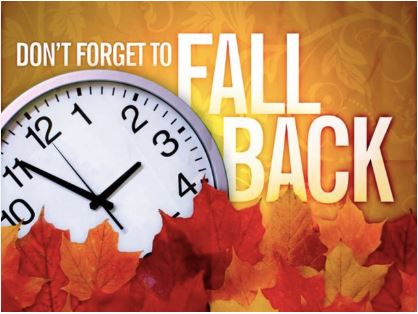As the leaves change colours and the air turns brisk, another seasonal transformation silently approaches, the fall back for Daylight Saving Time (DST). Regarded by many as a time-honored ritual, this one-hour shift in the clock has implications that ripple through our lives in more ways than one. But what exactly does fall back mean, and what benefits does it store for us?
Let’s explore why this annual time adjustment might be more advantageous than you think.
What Does Fall Back Mean In The Context Of Daylight Saving Time?
When we talk about fall back, we’re referring to the practice of setting our clocks back by one hour as Daylight Saving Time draws to a close. This simple act enables us to better align our daily routines with the limited daylight of the upcoming winter months.
Such an adjustment happens in the wee hours of a Sunday morning to ensure the transition impacts as few people as possible, gifting many with the luxury of an extra hour of slumber.
Digging a bit deeper, it’s clear that the shift is steeped in practicality; by reducing our dependency on artificial lighting, we save energy—a boon for both the environment and our wallets.
More than just a shift in time, “fall back” heralds the approach of winter, propelling us to adjust our schedules and embrace the cozy retreat of shorter days.
To illustrate the rich tapestry of changes brought on by this annual event, you’ll find that:
- Clocks rewind one hour during autumn to end Daylight Saving Time.
- People enjoy an extra hour of sleep on the night of the change.
- Energy consumption is optimized by leveraging natural light.
- This time change serves as a reminder for individuals to prepare for the winter season.
- Our biological clocks must adapt, affecting sleep patterns and daily routines.
As we tuck this information away, let’s appreciate the fall back for what it is — a time-honored cue to slow down, reset, and conserve as we transition into the depth of winter.
When Do We Need To Fall Back For Daylight Saving Time In The U.S.?
The moment we reset our clocks in the U.S. is as constant as the changing seasons — occurring on the first Sunday of November at 2 a.m. This practiced dance with time redistributes daylight from the evening to the morning, a nod to winter’s abbreviated days.
The occurrence of this changeover during the early morning of a weekend day ensures the slightest disturbance to our weekday routines of work and school.
Consider the following nuances and benefits of this timing:
- An extra hour of sleep is particularly welcome on this night, potentially aiding in sleep health and well-being.
- With darkness creeping earlier, energy use in the evenings may subside, leading to possible reductions in electricity bills.
Acknowledging these subtle yet impactful changes can help us maximize the fallback benefits each year.
How Will The Fall Back For Daylight Saving Impact My Daily Schedule?
The recalibration of time doesn’t just affect the mechanical clock; it also nudges our biological ones, offering bonuses that might go unnoticed without a closer look:
The fall back offers:
- An Extended Rest: You’ll get an extra hour of sleep, which might lead to a more rejuvenated morning.
- Shifts in Evening Plans: Expect to reschedule some of your outdoor endeavors or evening entertainment to bask in the daylight for a bit longer.
- Lighter Mornings: Easier wake-ups and potentially more vigorous starts to your days are on the horizon thanks to the extra morning light.
- Energy Efficiency: Consider the potential decrease in your electricity bills, as you might find little need for those bright bulbs in the early hours.
Remember to adjust your manual timekeepers and keep a keen eye on any appointment times that might be affected by the change.
Do All States In The U.S. Observe The Fall Back For Daylight Saving Time?
While the fall back is widespread, it’s not universally observed across the United States. States such as Arizona and Hawaii have chosen to step away from this practice, citing various reasons — from geographic location to public opinion.
Within Arizona, the Navajo Nation stands out for choosing to follow DST, demonstrating the variety of timekeeping practices within one state. The legal framework comes from the Uniform Time Act of 1966, allowing states to opt out of DST.
However, the act does draw a line; while states can choose to stick with Standard Time year-round, they need Congressional approval to make Daylight Saving Time permanent. And so, the debate continues as some states ponder discontinuing DST or making it a fixed standard.
When Does Daylight Savings Time End Permanently
Following the ongoing debate on the permanent end to daylight saving time, many people are left wondering what the future holds for this age-old practice of falling back.
As of now, daylight saving time in the United States typically ends on the first Sunday of November, marking the day when clocks go back one hour, providing an extra hour of sleep for many.
However, legislative efforts, such as the Sunshine Protection Act, have been proposed to make daylight saving time permanent, potentially eliminating the need to change our clocks twice a year.
While no official decision has been finalized at a federal level as of my knowledge the, the cutoff in 2023, the adoption of such a measure could lead to longer evenings throughout the year, impacting everything from energy consumption to our daily routines.
It’s important to stay informed on this topic, as any updates could significantly affect how we plan our days and align our schedules with the natural daylight. Keep an eye on official announcements and consider how a permanent daylight saving time might influence your lifestyle and well-being.
What States Are Getting Rid Of Daylight Savings Time
As various states move to abandon the annual time shift known as daylight saving time, many residents are gearing up for the immediate benefits of ‘falling back. Generally speaking, this practice, which involves setting clocks back one hour in the autumn, aims to provide extra daylight during evening hours in the spring and summer months.
However, as states seek to eliminate the need for a biannual clock change, it is vital for individuals to stay informed about how these changes might affect them. The transition out of daylight saving time can impact daily routines, and being ready for the switch is crucial.
Whether it’s adjusting sleep schedules, planning for commutes that may now occur in darker conditions, or preparing your home for earlier sunsets, understanding the implications of ‘fall back’ is key.
When Does Time Fall Back
The “fall back” period for Daylight Saving Time (DST) generally occurs in the autumn, offering many of us a much-welcome extra hour of sleep. Officially, the time transition happens at 2:00 AM on the first Sunday in November.
This marks when we turn our clocks back one hour, reverting to Standard Time from Daylight Saving Time. This annual event signals colder weather, shorter days, and the approaching end-of-the-year festivities.
To best prepare for this change, it’s essential to understand why it occurs and how it affects your daily life, such as changes in sleep patterns, potential impacts on your health, weather-related mood shifts, and alterations in your tech devices.
Adjusting to this time difference can be smooth if you plan accordingly. In this post, we’ll provide you with practical tips on how to seamlessly transition into the earlier nights and later mornings that accompany the end of DST.
Is Daylight Savings Time Ending
The debate surrounding the end of Daylight Savings Time (DST) continues to brew across various regions, with many questioning its relevance in today’s world.
As we transition from summer to autumn, the annual ritual of ‘falling back’ – turning our clocks one hour back to standard time – prompts discussions about the benefits and drawbacks of this time-honored practice.
Experts argue about the impact of DST on energy savings, while health professionals discuss its effects on our circadian rhythms.
Additionally, a growing movement is advocating for permanent standard time, or conversely, permanent DST, citing the advantages of stability in our schedules. However, for the time being, the tradition persists in many areas, so it is important to prepare for the impending shift.
Staying informed about the timeline for when daylight savings time is potentially ending in your region is crucial for personal planning and can affect various aspects of daily life, from business operations to travel schedules.
Fall Back, How Daylight Saving Time Can Seriously Affect Your Health
As the clocks retreat one hour with the arrival of daylight saving time in the fall, many of us look forward to the extra hour of sleep we gain. However, this shift in time does more than just alter the position of the hands on our clocks; it can have significant implications for our physical and mental well-being.
The sudden change in daylight patterns can disrupt our circadian rhythms, the body’s natural clock, leading to a range of health issues. Studies have shown links between the transition out of daylight saving time and an increase in heart attacks, strokes, and depressive episodes.
Furthermore, the increase in darkness during the evening commute can contribute to a rise in traffic accidents. Understanding how ‘falling back’ can impact your body is crucial and what steps you can take to mitigate these adverse effects is crucial.
By sticking to a regular sleep schedule, getting exposure to natural light during the day, and avoiding screens before bed, you can help your body adjust to the time change and protect your health during the transition.
Which States And Federal Districts Use Daylight Saving Time In 2024
In 2024, Daylight Saving Time (DST) continues to be a practice observed by most states and federal districts across the United States.
The protocol requires clocks to “fall back,” typically providing many Americans an extra hour of sleep. As the season transitions and daylight hours shrink, it’s important to note which regions participate in this time-honored tradition.
Most states, including populous ones like California, Texas, and New York, will dutifully set their clocks back one hour come November, marking the end of DST.
However, there are exceptions. States like Arizona (except for the Navajo Nation) and Hawaii, along with the territories of Puerto Rico, the Virgin Islands, Guam, and American Samoa, do not observe Daylight Saving Time and will remain unaffected by the shift.
Residents and travelers must stay informed about these regional adaptations to ensure punctuality in personal and professional engagements. As we approach the “fall back” period, prepare for the adjustment and embrace the subtle changes in your daily routine that accompany Daylight Saving Time’s end.
Embracing the Clockwork Shift
Fall back is more than just an hour gained in sleep or a temporal curiosity — it’s a period of adaptation that promises brighter mornings, sensible energy consumption, and a gentle reminder of the year’s rhythms. As we adjust our clocks, we also reset our habits, often leading to improvements in our daily lives.
Whether it’s the novelty of adjusting non-digital devices or the sheer pleasure of an additional hour under the covers, there’s something intrinsically human about this collective shift.
So, as we prepare to turn back the dials this upcoming season, let’s celebrate the unique benefits the “fall back” for Daylight Saving Time provides.


